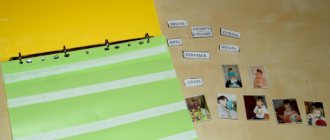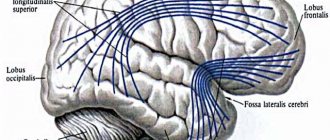The topic of our article is quite relevant since the motor skills of the fingers are closely interconnected with all mental processes, including speech. So A.V. Sukhomlinsky O. Indeed, well-developed fine motor skills have a beneficial effect on the development of all mental aspects. Fine motor skills are motor activities that are aimed at performing small movements with the hands and fingers and toes.
Scientists such as M.M. Koltsova, L.V. Antakova-Fomina, E.I. Isenin believe that the development of children’s speech directly depends on how the subtle movements of the fingers are formed.
To understand exactly how speech and movement are connected, let’s look at the three human brain centers that are responsible for speech. "Broca's area" or motor center produces speech; The speech organs take part in this. The “Wernicke's center” or auditory center is responsible for speech perception, the ability to recognize by ear. And thanks to the third “associative” centers, a person thinks through and analyzes the speech utterance. This is the process of human speech. With insufficient motor activity, the development of speech functions slows down.
Many researchers believe that the activity of the speech center in the central hemisphere of the brain is due to the leading role of the hand in human labor activity. F. Engels notes that the human brain develops under the influence of work and articulate speech.
The close relationship between hand movements and speech was traced in the studies of M.I. Zvonareva and T.P. Chrisman. The study found that when a child performs rhythmic movements with his fingers, the coordinated activity of the frontal and temporal regions of the brain sharply increases. This means that the speech areas of the brain are formed from impulses coming from the fingers.
When performing any movements, all analyzers take part (visual, auditory, tactile, and so on). In this case, the environment and its impact on the child play an important role. Starting from a very early age, it is necessary to pay attention to the development of both gross and fine motor skills. Finger movements occur from a very early age and are improved by the age of six. By this age, he independently performs various manipulations with objects.
T.B. Filicheva notes that imperfections in the development of fine motor skills of children with general speech underdevelopment affect the accuracy of movements, their speed and switchability. Such a child is not able to perform movements smoothly and quickly, or switch from one action to another. Children with general speech underdevelopment find it difficult to differentiate hand movements; they do not recognize some objects by touch (finger gnosis).
A neurological examination of children with general speech underdevelopment reveals the following features: awkward, undifferentiated movements; when overworked, synkenesis (friendly movements) are noted; make mistakes in spatial organization; movements are constrained, not synchronous; tremor (rapid movements of the fingers) is noted; control of one's own actions is impaired.
Thus, children with speech development disorders, later than children with normal speech development, begin to grab and hold objects, sit, walk, and jump on one and two legs. Underdevelopment of fine motor skills causes difficulties in lacing, fastening and unfastening buttons, and holding a spoon and fork in the correct position.
In children with general speech underdevelopment, along with poor coordination of movements, excessive motor activity is observed, which is characterized by sweeping, strong movements. Children with disorders of all aspects of speech have difficulties in the interaction of analyzers, that is, visual-motor and auditory-motor coordination is impaired. For example, when copying, a child with general speech underdevelopment makes many mistakes and distorts the drawing. Or when writing, the child writes letters incorrectly.
When studying auditory-motor coordination of movements, children with ODD make many mistakes. So, the child is given a sample of performing a task by ear - it is necessary to remember the rhythm of tapping in the absence of visual control and then reproduce it. In most cases, children either cope poorly with such a task or do not resort to performing it at all.
The hand movements of children with OHP are not coordinated; it may be difficult for them to perform movements with both hands at once. For example, when assembling a pyramid, a child cannot hold the base with one hand and string rings onto the rod with the other hand.
The so-called “fist, rib, palm” test by N.I. Ozeretskiy is difficult for children to complete. The meaning of the task is this: the child is alternately shown three different positions of his hands on the table, which change sequentially. This is a palm on the plane of the table, a fist, a palm with an edge on the surface. The child needs to complete this task together with the teacher, and then reproduce the same thing independently. As a rule, children with general speech underdevelopment perform this test more slowly than their peers whose speech development is normal. In addition, they get confused in the sequence when performing a task and perform it awkwardly.
Children with ODD find it most difficult to perform tasks in which the position of both hands changes simultaneously. They often make mistakes, make unnecessary movements or shorten them, and can reproduce the same movement without changing position.
Features of motor development are clearly visible in children's visual arts. Children with general speech underdevelopment are poorly oriented on a sheet of paper. They find it difficult to draw a straight line or draw small details, and this, in turn, later affects their writing. This is noticeable when a child writes a letter incorrectly or distorts it; "moves" off the line when writing sentences.
The development of fine motor skills is of great importance when teaching a child with ODD. At the same time, it is important to remember the development of all components that affect the child’s speech development. Thus, it is necessary to train coordination of movements, spatial coordination, motor memory, voluntary motor skills of the fingers; it is necessary to develop dynamic praxis, coordination of hand and eye movements.
Thus, fine motor skills play a big role in the development of a child’s speech. Its development is especially important when teaching a child with general speech underdevelopment, because speech movements are inextricably linked.
ONR: what is this?
You can suspect a general speech underdevelopment in a child if he said his first words late - by the age of 3 or even later; does not fulfill requests and exhibits low speech activity, does not try to verbally express his desires, and has neurological problems.
In children, not only the process of speech development as a whole is disrupted, but also the sequence and timing of mastering speech skills. In addition, they lag behind the age norm in other criteria, such as mental development.
OHP 1: characteristic of the violation
General underdevelopment of level 1 speech in a young child is characterized by the following signs:
- unformed phrasal speech;
- poor vocabulary;
- reducing sentences to one word;
- misunderstanding of the meanings of words, situational understanding of speech;
- features of articulation: it is incorrect, unclear, the baby pronounces sounds incorrectly or they are completely inaccessible to him;
- rearranging syllables, reducing words to 1 - 2 syllables;
- phonemic analysis of words is not available;
- the use of babble, gestures, facial expressions, amorphous words, and onomatopoeia in communication. Moreover, facial expressions are always applied to the location.
Thus, you don’t even need to be a doctor to understand that the baby has problems.
Level 1 ONR forms
There are 4 clinical forms of general speech underdevelopment of level 1. These include childhood aphasia, alalia, rhinolalia and dysarthria.
Childhood aphasia is an extremely rare disease, occurring in only 1% of children. They do not perceive and recognize speech poorly, do not master phrasal speech, and have difficulty establishing contact with other people. Childhood aphasia is very difficult to recognize in the early stages, so it is usually diagnosed late.
Alalia is underdevelopment of speech or its absence with intact hearing and intelligence. There are sensory and motor alalia. Children with motor alalia can begin to speak by the age of 4, they have poor coordination and fine motor skills, they replace some words with others, cannot express their thoughts, they have no desire to speak, they are touchy. With sensory alalia, children perceive speech incorrectly, repeat words after others, combine two words into one, and they often lack a connection between an object and the word denoting it. Such children can be withdrawn or, conversely, impulsive and very active.
Rhinolalia is manifested by incorrect sound pronunciation and changes in voice timbre. Rhinolalia is associated with impaired velopharyngeal closure.
Dysarthria is difficulty or distorted pronunciation of sounds and words. Associated with impaired innervation and limited mobility of the speech apparatus against the background of damage to the central nervous system.
As children with level 1 ODD say
Children with this diagnosis cannot use verbal means of communication - at all or partially.
Here are examples of level 1 OHP:
- they babble and make sounds: “dada” - “give”, “may” - “meow”;
- they speak only the root part of the word: “ku” - “doll”, “gu” - “toy”;
- denote several objects in one word: “ba” - “banana” and “apple”;
- denote in one word both objects and actions: “bibi” - any transport and “go”, “oko” - open and close a window;
- the same words are pronounced differently each time: “bus” - “abas”, “bass” “pencils” - “adshi”, “udas”;
- they shorten complex words: “the dog is sitting” - “paka di”, “we were walking on a hill” - “goka gi”.
Often such children do not understand the instructions of the speech therapist - they do not have enough vocabulary for this.
Causes of 1st degree OHP
Various factors can lead to speech impairment. They can be divided into several groups:
- Intrauterine development. Bad habits of the mother, severe toxicosis, use of drugs prohibited during pregnancy, alcohol or drugs, asphyxia or hypoxia of the fetus, severe traumatic birth - as a result of these factors, the central nervous system of the newborn is damaged, which means there is a high risk of neurological problems, including speech disorders;
- The baby's health status. Frequent hospitalization, illness in the first years of life, traumatic brain injuries, neuroinfections, chronic diseases - all this affects his mental development, including further speech acquisition;
- Social factors. Negative, emotionally tense family environment, pedagogical neglect, indifferent or cruel treatment of the child, emotional shocks and traumas, affects, as well as ignorance of delayed speech development, which can subsequently turn into underdevelopment.
The prenatal period and the first year of life play a huge role in the mental development of children.
Comprehensive diagnosis of the disease
The examination involves a pediatrician, neurologist, otolaryngologist, speech pathologist, and psychiatrist.
The pediatrician assesses the general health of the little patient and provides referrals for consultations with specialized specialists.
The otolaryngologist evaluates hearing acuity and excludes deafness.
A psychiatrist assesses the mental health of a small patient and excludes diseases according to his profile, which may also be accompanied by impaired speech development. This includes, for example, autism.
But the leading role is assigned to the neurologist and speech therapist. It is these specialists who diagnose the disease, assess its severity, identify the cause and develop a treatment regimen.
A neurologist assesses the patient’s neurological status, prescribes hardware diagnostics (for example, MRI of the brain), determines the cause of speech disorders and makes recommendations to a speech therapist. For type 1 OHP, the neurologist usually prescribes drug therapy, physiotherapy, and massage.
Speech therapy correction
A speech pathologist-defectologist determines the child’s speech status. First, he collects an anamnesis - from the opinions of other specialists and information provided by the parents. He asks the parents how the pregnancy proceeded, when the baby began to show speech activity (for example, began to coo), when he said the first word, how much he generally strives to communicate - all this is very important.
Then the speech therapist studies the child’s speech apparatus and examines the components of the language: features of sound pronunciation, the little patient’s ability to compose a meaningful, coherent and literate text, and the volume of vocabulary.
Based on the data obtained, the specialist makes a final diagnosis: the form and degree of speech development disorder, and also prescribes a correction program.
Since in group 1 OHP all parts of the language system are severely underdeveloped, the child does not speak common speech, a speech therapist teaches him to understand speech addressed to him, increases speech activity, and activates speech imitation.
Additionally, the small patient is prescribed speech therapy massage (normalizes speech muscles to make it easier for him to pronounce sounds), microcurrent treatment (activates the speech centers of the brain) and drug therapy. All these procedures are prescribed by a neurologist.
The correction of grade 1 OHP is approached in a comprehensive manner. It is impossible to achieve results on your own at home, so the child must systematically study with a speech therapist-defectologist. Exercising at home with your parents is also important - a specialist will give you a set of exercises. All exercises are performed in the form of a game. As a rule, children with grade 1 ODD are trained individually, although sometimes classes are conducted in groups of 2–3 people.
Only this approach will help the child move to a higher level of speech development and master new skills.
Complications of type 1 OHP
Neurologists and speech therapists say that up to the age of 3, children can speak the way they want and the way they can. Each baby has its own pace of development, so your son or daughter may not “fit” into the age range. But if a child is 3 years old and has only said his first word, this may already indicate a delay in speech development.
If, at the age of 5, he speaks at the level of a two-year-old (slowly, not in sentences, incoherently), his speech is illiterate and incomprehensible, then it is worth urgently showing him to a neurologist or speech therapist. Even if your child understands speech addressed to him and fulfills requests, do not expect him to speak out on his own. You can only waste time. Namely, it plays a decisive role in the correction of the first level of OHP.
If you ignore the problem, it will progress quickly. And this goes beyond just speech: against the backdrop of worsening speech underdevelopment, the baby’s mental development is also disrupted. He cannot think productively, does not remember well, his physical development, coordination of movements, and fine motor skills suffer.
Further - worse. Personal changes also occur: the child becomes withdrawn, does not want to communicate with peers and parents, becomes indifferent to everything, self-esteem decreases, and behavioral disorders begin.
Children with speech underdevelopment cannot master the curriculum of a regular school, so they are sent to special schools.
As a result, mental retardation is formed against the background of a general speech disorder.
Prognosis and prevention of disorders
The prognosis depends on various factors - the cause and form of the disorder, the timeliness of the correction started, and the regularity of classes. Such children have fully intact compensatory capabilities, so they quickly respond to corrective measures. The earlier treatment begins, the better results can be achieved. If the child is 3 years old, this is the best time to start correction - by the age of 5 - 7 years, you can bring his speech closer to normal or completely eliminate the problem. If you ignore the disease, it will only progress.
No one is immune from speech pathologies. Therefore, for the purpose of prevention, it is better to show a child aged 2.5 to 3 years to a speech therapist. The specialist will assess the speech status of the little patient. And if it reveals a discrepancy with age standards, it will immediately begin correction.
Family also plays a huge role. A friendly atmosphere in the home and a warm attitude are the foundations for the normal development of any child. Parents should engage with their daughter or son: talk to him, tell him, explain, play, communicate, engage him in dialogue - all this activates speech activity.








